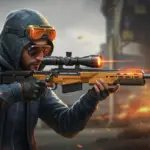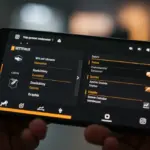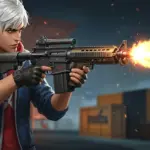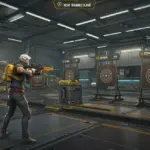Free Fire Pro Tips: Master Headshots & Boost Accuracy by 25%
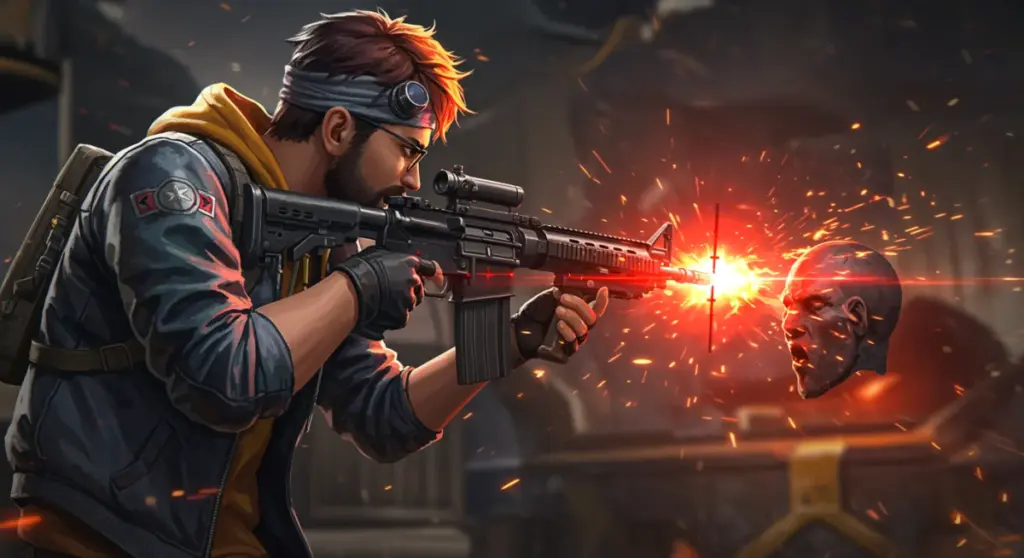
Anúncios
Mastering headshots in Free Fire is crucial for rapid eliminations and victory, and this guide offers expert strategies, optimal sensitivity settings, and dedicated practice routines to significantly boost your accuracy by at least 25%.
Are you ready to transform your Free Fire gameplay and leave opponents in awe? Learning Free Fire Pro Tips: Master the Art of Headshots and Increase Accuracy by 25% is not just about aiming; it’s about understanding game mechanics, refining your technique, and consistent practice. This guide will reveal the secrets to consistently landing those critical headshots, turning you into a formidable player on the battlefield.
Understanding Free Fire’s aiming mechanics
Before diving into specific techniques, it’s essential to grasp how Free Fire’s aiming system functions. Unlike some other battle royales, Free Fire incorporates a degree of aim assist, which, when properly utilized, can be a powerful tool for landing precise shots. However, relying solely on aim assist won’t lead to headshot mastery. True proficiency comes from understanding bullet drop, recoil patterns, and how your chosen weapon behaves under different circumstances.
The game’s aiming mechanism requires a delicate balance between manual control and leveraging the inherent aim assist. Many players struggle because they either fight the aim assist or become too dependent on it. The key is to use aim assist as a foundation and then manually adjust for the headshot, often with a quick, upward drag motion. This initial understanding sets the stage for all subsequent advanced techniques.
Recoil control and weapon stability
Every weapon in Free Fire has a unique recoil pattern, which dictates how much your crosshair jumps after each shot. Mastering recoil control is paramount for accuracy, especially when aiming for headshots. Different attachments, such as foregrips and stocks, can significantly reduce recoil, making your weapon more stable and easier to control during sustained fire. It’s crucial to experiment with various attachments to find the combination that best suits your playstyle and weapon of choice.
- Muzzles: Reduce bullet spread and increase range.
- Foregrips: Significantly reduce vertical and horizontal recoil.
- Stocks: Improve weapon stability and movement speed while aiming.
- Scopes: Enhance vision but can sometimes amplify perceived recoil.
Practicing with different weapons to learn their individual recoil patterns will give you a distinct advantage. Knowing how to compensate for recoil allows you to keep your crosshair on target, even when firing multiple shots, directly contributing to higher headshot percentages. This foundational knowledge is often overlooked but is a cornerstone of professional-level play.
Ultimately, becoming proficient in Free Fire’s aiming mechanics is a journey of continuous learning and adaptation. By understanding the interplay of aim assist, recoil, and weapon attachments, you lay a solid groundwork for mastering headshots and elevating your overall accuracy to professional levels.
Optimizing sensitivity settings for precision
Your sensitivity settings are arguably the most critical factor in achieving consistent headshots and improving overall accuracy. There’s no one-size-fits-all solution; optimal sensitivity is highly personal and depends on your device, screen size, and playstyle. However, there are general principles and starting points that can guide you toward finding your perfect configuration.
High sensitivity allows for quicker turns and flick shots, which are essential for reacting to fast-moving targets and performing the ‘drag headshot’ technique. Conversely, low sensitivity offers more control for precise adjustments and long-range engagements. The goal is to find a balance that enables both speed and precision, allowing you to fluidly track targets and make micro-adjustments for headshots.
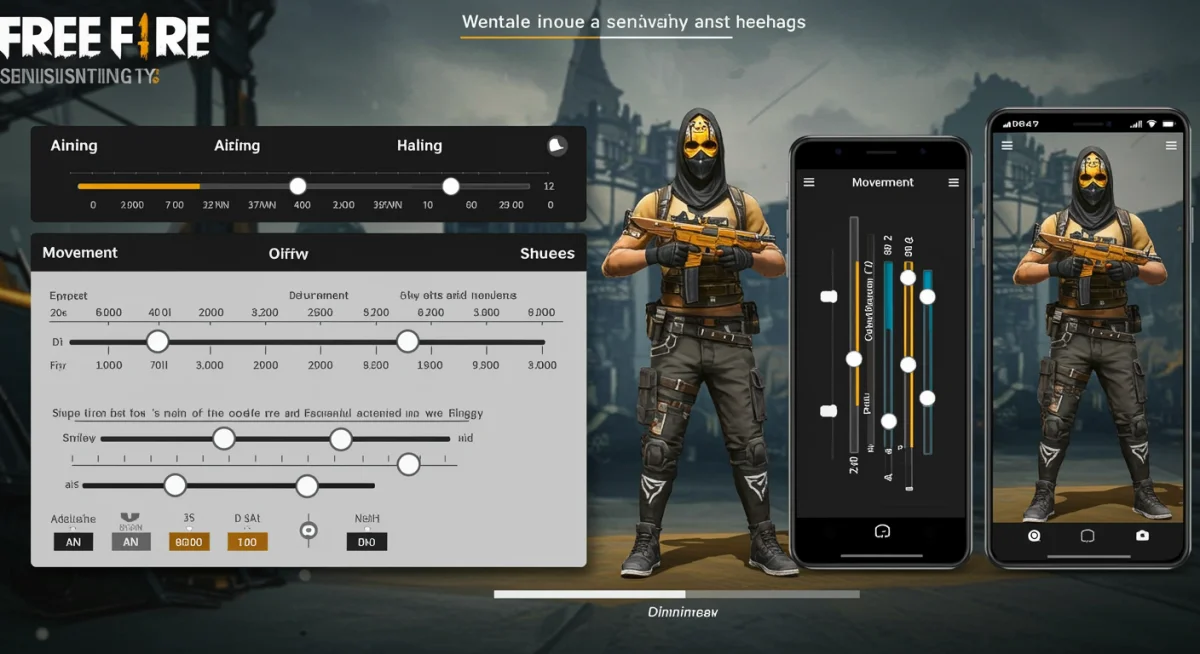
General and red dot sensitivity
Your ‘General’ sensitivity controls camera movement when not aiming down sights (ADS), while ‘Red Dot’ sensitivity affects aiming with a red dot sight. A higher general sensitivity allows for quicker situational awareness and faster rotations, which is vital in close-quarters combat. For red dot, a slightly lower setting might be beneficial to maintain control during spray transfers, but still high enough to perform drag headshots effectively.
- General (Look): Start between 90-100 for quick turns and situational awareness.
- Red Dot: Experiment between 70-85 for a balance of speed and control.
Remember, these are starting points. The best way to fine-tune these settings is through extensive practice in the training ground. Pay close attention to how quickly you can acquire targets and how much effort it takes to land a headshot. Slight adjustments, even by 1 or 2 points, can make a significant difference in your performance.
Finding your ideal sensitivity is an iterative process. Don’t be afraid to tweak settings and test them rigorously. A comfortable and optimized sensitivity setup will dramatically enhance your ability to land headshots, making your movements smoother and your aim more consistent.
Mastering the drag headshot technique
The drag headshot technique is a cornerstone of high-level Free Fire gameplay, allowing players to consistently land headshots, especially in close to medium-range engagements. This technique involves a rapid upward swipe of your finger on the screen while firing, effectively ‘dragging’ your crosshair from the enemy’s body to their head. It requires precise timing and a well-calibrated sensitivity setting.
The beauty of the drag headshot lies in its ability to bypass the chest and directly target the head, maximizing damage and securing quick eliminations. It’s particularly effective with weapons that have high fire rates, such as SMGs and assault rifles, as it turns body shots into critical headshots with a single, fluid motion. However, mastering it demands consistent practice and muscle memory development.
Executing the drag headshot with precision
To perform a drag headshot, first, ensure your crosshair is initially pointed at the enemy’s body or slightly below. As you press the fire button, simultaneously swipe your finger upwards on the screen. The speed and distance of your swipe will depend on your sensitivity settings and the distance to the target. For closer enemies, a shorter, faster swipe is often sufficient, while longer distances might require a more deliberate, controlled drag.
- Initial aim: Target the enemy’s chest or lower body.
- Fire and drag: Press fire button and quickly swipe finger upwards.
- Practice: Refine speed and distance in the training ground.
The key is to make the drag motion smooth and continuous. Jerky or inconsistent swipes will lead to missed shots. It’s also important to understand that different weapons will require slightly different drag speeds and distances. Shotguns, for instance, often benefit from a very quick, sharp flick upwards, while assault rifles might require a more sustained drag for multiple shots.
Mastering the drag headshot technique will undoubtedly elevate your Free Fire gameplay. It transforms ordinary engagements into opportunities for swift, decisive eliminations, making you a much more efficient and dangerous player on the battlefield.
Effective practice routines and drills
Talent alone won’t get you to the top in Free Fire; consistent and effective practice is what truly hones your skills. A structured practice routine, focusing specifically on headshot accuracy, is essential for seeing tangible improvements. The training ground is your best friend for this, offering a safe environment to experiment and refine techniques without the pressure of a live match.
Your practice routine should encompass various aspects of aiming, including static target practice, moving target tracking, and quick flick shots. Don’t just mindlessly shoot; approach each session with a specific goal in mind, whether it’s improving your drag headshot consistency or reducing the time it takes to acquire a target’s head.
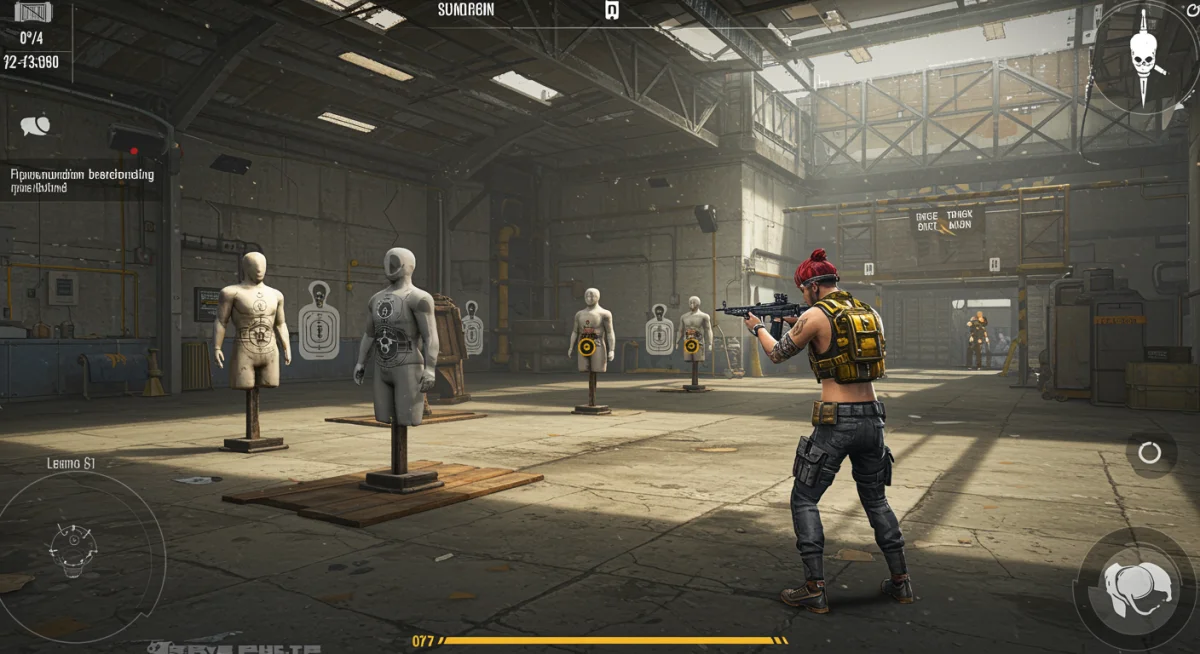
Target practice and movement drills
Start your practice by focusing on static targets. Aim for their heads and practice the drag headshot technique until it feels natural. Once comfortable, introduce movement into your drills. Run and jump while trying to hit headshots on moving targets. This simulates real combat scenarios where enemies are rarely standing still.
- Static headshots: Practice drag headshots on stationary targets.
- Moving target tracking: Follow moving targets with your crosshair while firing.
- Flick shots: Quickly snap your aim to a target’s head from an off-center position.
Another effective drill is to practice with different weapon types. Each weapon has its unique feel and recoil, and adapting your aiming technique to each will make you a more versatile player. Spend at least 15-30 minutes in the training ground before jumping into ranked matches. This serves as a warm-up and a dedicated skill-building session.
By integrating these effective practice routines and drills into your daily Free Fire sessions, you’ll build the muscle memory and precision necessary to consistently land headshots, significantly boosting your overall accuracy and in-game performance.
Advanced positioning and crosshair placement
While mechanical skill is crucial, strategic positioning and intelligent crosshair placement are equally vital for maximizing headshot opportunities. Pro players understand that half the battle is won before the first shot is even fired, simply by having superior positioning and anticipating enemy movements. This strategic approach minimizes the need for drastic aim adjustments, making headshots easier to execute.
Good crosshair placement means keeping your crosshair at head level as you move around the map, especially when peeking corners or entering new areas. This way, if an enemy appears, your crosshair is already in the optimal position for a headshot, requiring only a minimal adjustment or drag. It’s a proactive approach to aiming that significantly reduces reaction time.
Anticipation and pre-aiming
Anticipation involves predicting where enemies might appear and pre-aiming at those locations. For instance, if you’re approaching a common choke point or a building known for enemy camping, keep your crosshair fixed at head level on the expected entry or exit points. This allows you to react instantly and secure the first shot, often a headshot.
- Head-level placement: Always keep your crosshair at head height.
- Corner peeking: Pre-aim corners at head level before exposing yourself.
- High ground advantage: Utilize elevated positions for easier headshot angles.
Furthermore, understanding map flow and common rotation paths can help you position yourself to catch enemies off guard. Flanking maneuvers, for example, often present opportunities to engage unaware enemies from advantageous angles, making headshots much simpler. Combine this with smart use of cover, and you become a very difficult target to hit while being a lethal threat yourself.
By integrating advanced positioning and diligent crosshair placement into your gameplay, you’ll create more favorable engagements for yourself, allowing your mechanical aiming skills to shine and resulting in a higher frequency of devastating headshots.
Mindset and mental game for consistent performance
Beyond technical skills, the mental aspect of Free Fire plays a significant role in consistent performance and headshot accuracy. A calm, focused, and adaptable mindset can make all the difference, especially in high-pressure situations. Panicking or getting frustrated after a missed shot can lead to a downward spiral of poor decisions and further inaccuracy.
Maintaining composure allows you to execute techniques like the drag headshot with precision, even when under fire. It also helps in making quick, strategic decisions, such as when to engage, when to disengage, and when to push for an advantage. A strong mental game ensures that your skills translate effectively into in-game results.
Staying focused and adaptable
Minimize distractions during gameplay. A focused mind can better process information, track enemies, and execute precise movements. If you find yourself getting frustrated, take a short break to reset. Remember that every match is an opportunity to learn and improve, regardless of the outcome.
- Stay calm: Avoid panicking under pressure.
- Learn from mistakes: Analyze what went wrong and how to improve.
- Positive self-talk: Maintain a confident and optimistic outlook.
Adaptability is another key component. No two Free Fire matches are exactly alike. The enemy’s strategy, the zone’s movement, and the loot you find will always vary. Being able to adjust your playstyle, weapon choice, and tactics on the fly is crucial for success. This mental flexibility ensures that you can always find a path to victory, even when facing unexpected challenges.
Cultivating a resilient mindset and a strong mental game will not only improve your headshot accuracy but also enhance your overall enjoyment and long-term success in Free Fire. Remember, the best players are not just skilled with their fingers; they are also masters of their minds.
| Key Technique | Brief Description |
|---|---|
| Drag Headshot | Rapid upward swipe while firing to move crosshair from body to head, crucial for close-range eliminations. |
| Sensitivity Optimization | Fine-tuning in-game settings for balanced speed and precision, adapting to personal playstyle and device. |
| Crosshair Placement | Maintaining crosshair at head level proactively, minimizing aim adjustments during unexpected encounters. |
| Recoil Control | Understanding and compensating for weapon recoil patterns to maintain accuracy during sustained fire. |
Frequently asked questions about Free Fire headshots
There’s no single ideal sensitivity; it’s highly personal. Start with General 90-100 and Red Dot 70-85, then adjust in the training ground. Focus on finding a balance that allows for quick turns and precise micro-adjustments for headshots, ensuring comfort and responsiveness on your device.
Consistent practice is key. Aim for at least 15-30 minutes daily in the training ground before playing ranked matches. Focus on specific drills like static and moving target headshots, and flick shots to build muscle memory and refine your aiming techniques over time.
Aim assist can be a powerful tool if used correctly. It helps in initial target acquisition. However, relying solely on it won’t guarantee headshots. The best approach is to let aim assist get your crosshair near the body, then manually drag it up for the headshot.
Assault Rifles (ARs) like the M4A1 or SCAR are excellent for practicing drag headshots due to their versatility. SMGs are good for close-range flick shots, while snipers require extreme precision. Practice with a variety to become a well-rounded player and adapt to different combat scenarios effectively.
Absolutely. A calm, focused mindset reduces panic, allowing for better decision-making and more precise execution of aiming techniques. Frustration can lead to rushed shots and decreased accuracy. Maintaining composure and a positive attitude is crucial for consistent high-level performance.
Conclusion
Mastering headshots and significantly boosting your accuracy in Free Fire is an achievable goal that transcends mere luck; it’s a culmination of understanding game mechanics, optimizing your settings, refining your techniques, and cultivating a winning mindset. By consistently applying the Free Fire Pro Tips: Master the Art of Headshots and Increase Accuracy by 25% outlined in this guide – from perfecting the drag headshot to strategic crosshair placement and dedicated practice – you are not just improving your aim, but fundamentally transforming your overall gameplay. Embrace the journey of continuous improvement, and you’ll soon find yourself dominating the battlefield with unparalleled precision and confidence, securing more victories and leaving a lasting impact on every match you play.
